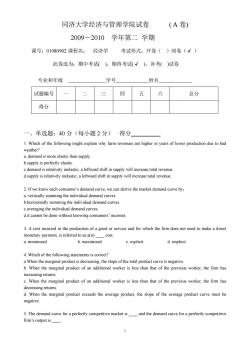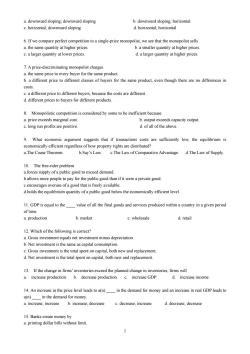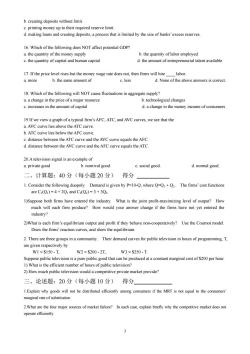同济大学:《经济学》课程教学资源(试卷习题)期终考试试卷(A卷)试题

同济大学经济与管理学院试卷 (A卷) 2009一2010学年第二学期 课号:01080902课程名:经济学考试形式:开卷()闭卷(√) 此卷选为:期中考试()期终考试(√)、补考()试卷 专业和年级 学号 姓名 试题编号 四 六 总分 得分 一、单选题:40分(每小题2分)得分 1.Which of the following might explain why farm revenues are higher in years of lower production due to bad weather? a.demand is more elastic than supply. b.supply is perfectly elastic. c.demand is relatively inelastic;a lefward shift n supply will increase total revenue 2.If we know each consumer's demand curve,we can derive the market demand curve by: a.vertically summing the individual demand curves. b.horizontally summing the individual demand curves 3.A cost incurred in the production of a good or service and for which the firm does not need to make a direct monetary pavment.is referred to as a(n) cost. .minimized b.maximized c.explicit d.implicit 4.Which of the following statements is correct? a.When the marginal product is decreasing.the slope of the total product curve is negative. b.When the marginal product of an additional worker is less than that of the previous worker.the firm has whethe rginroofworker is es than that of the previous worker,them decreasing returns. d.When the marginal product exceeds the average product,the slope of the average product curve must be negative. 5.The demand curve for a perfectly etitive market is and the demand curve for a perfectly competitive firm's output is
1 同济大学经济与管理学院试卷 ( A 卷) 2009-2010 学年第二 学期 课号:01080902 课程名: 经济学 考试形式:开卷( )闭卷(√ ) 此卷选为:期中考试( )、期终考试(√ )、补考( )试卷 专业和年级 学号 姓名 一、单选题:40 分(每小题 2 分) 得分 1. Which of the following might explain why farm revenues are higher in years of lower production due to bad weather? a. demand is more elastic than supply. b.supply is perfectly elastic. c.demand is relatively inelastic; a leftward shift in supply will increase total revenue. d.supply is relatively inelastic; a leftward shift in supply will increase total revenue. 2. If we know each consumer’s demand curve, we can derive the market demand curve by: a. vertically summing the individual demand curves. b.horizontally summing the individual demand curves. c.averaging the individual demand curves. d.it cannot be done without knowing consumers’ incomes. 3. A cost incurred in the production of a good or service and for which the firm does not need to make a direct monetary payment, is referred to as a(n) ____ cost. a. minimized b. maximized c. explicit d. implicit 4. Which of the following statements is correct? a.When the marginal product is decreasing, the slope of the total product curve is negative. b. When the marginal product of an additional worker is less than that of the previous worker, the firm has increasing returns. c. When the marginal product of an additional worker is less than that of the previous worker, the firm has decreasing returns. d. When the marginal product exceeds the average product, the slope of the average product curve must be negative. 5. The demand curve for a perfectly competitive market is ____ and the demand curve for a perfectly competitive firm’s output is ____. 试题编号 一 二 三 四 五 六 总分 得分

a.downward sloping:downward sloping b.downward sloping,horizontal c.horizontal,downward sloping d horizontal:horizontal 6.If we compare perfect competition to a single-price monopolist,we see that the monopolist sells a.the same quantity at higher prices. b.a smaller quantity at higher prices c.a larger quantity at lower prices. d.a larger quantity at higher prices 7.Apric-discriminating monopolist charge a the same price toevery buyer for the same product. b.a different price to different classes of buyers for the same product,even though there are no differences in costs. c.a different price to different buvers.because the costs are different. d.different prices to buyers for different products. 8.Monopolistic competition is considered by some to be inefficient because a.price exceeds marginal cost. b.output exceeds capacity output. c.long run profits are positive. d.of all of the above. 9 What economic argument suggests that if transactions costs are sufficiently low,the equilibrium is conmically fc regardess of how property rights are distributed? a.The Coase Theorem. b.Say's Law.c.The Law of Comparative Advantage.d.The Law of Supply. 10.The free-rider problem a forces supply of a public good to exceed demand. good than if it were a private good c.encourages overuse of a good that is freely available. d holds the equilibrium quantity of a public good below the economically efficient level. 11.GDP is equal to the value of all the final goods and services produced within a country in a given period of time. a.production b.market c.wholesale d.retail 12.Which of the following is correct? a.Gross investment equals net investment minus depreciation b.Net investment is the same as capital consumptior Net inestment is the total spent on capital both newnd re the total spent on capital,both new and replacement 13.If the change in firms'inventories exceed the planned change in inventories,firms will a.increase production.b.decrease production.c.increase GDP d.increase income 14.An increase in the price level leads toa(n)in the demand for money and an increase in real GDP leads to a(n)in the demand for money. a.increase;increase b.increase;decrease c.decrease;increase d.decrease;decrease 15 Banks create m
2 a. downward sloping; downward sloping b. downward sloping; horizontal c. horizontal; downward sloping d. horizontal; horizontal 6. If we compare perfect competition to a single-price monopolist, we see that the monopolist sells a. the same quantity at higher prices. b. a smaller quantity at higher prices. c. a larger quantity at lower prices. d. a larger quantity at higher prices. 7. A price-discriminating monopolist charges a. the same price to every buyer for the same product. b. a different price to different classes of buyers for the same product, even though there are no differences in costs. c. a different price to different buyers, because the costs are different. d. different prices to buyers for different products. 8. Monopolistic competition is considered by some to be inefficient because a. price exceeds marginal cost. b. output exceeds capacity output. c. long run profits are positive. d. of all of the above. 9. What economic argument suggests that if transactions costs are sufficiently low, the equilibrium is economically efficient regardless of how property rights are distributed? a.The Coase Theorem. b.Say’s Law. c.The Law of Comparative Advantage. d.The Law of Supply. 10. The free-rider problem a.forces supply of a public good to exceed demand. b.allows more people to pay for the public good than if it were a private good. c.encourages overuse of a good that is freely available. d.holds the equilibrium quantity of a public good below the economically efficient level. 11. GDP is equal to the ____ value of all the final goods and services produced within a country in a given period of time. a. production b. market c. wholesale d. retail 12. Which of the following is correct? a. Gross investment equals net investment minus depreciation. b. Net investment is the same as capital consumption. c. Gross investment is the total spent on capital, both new and replacement. d. Net investment is the total spent on capital, both new and replacement. 13. If the change in firms’ inventories exceed the planned change in inventories, firms will a. increase production. b. decrease production. c. increase GDP. d. increase income. 14. An increase in the price level leads to a(n) ____ in the demand for money and an increase in real GDP leads to a(n) ____ in the demand for money. a. increase; increase b. increase; decrease c. decrease; increase d. decrease; decrease 15. Banks create money by a. printing dollar bills without limit

b.creating deposits without limit. c.printing money up to their required reserve limit. d.making loans and creating deposits,a process that is limited by the size of banks'excess reserves. 16.Which of the following does NOT affect potential GDP? a.the quantity of the money supply b.the quantity of labor employed c.the quantity of capital and human capital d.the amount of entrepreneurial talent available 17.If the price level rises but the money wage rate does not,then firms will hire labor. a.more b.the same amount of c.less d.None of the above answers is correct. 18.Which of the following will NOT cause fluctuations in aggregate supply? a.a change in the price of a major resource b.technological changes c.increases in the amount of capital d.a change in the money income of consumers 19 If we view a graph of a typical firm's AFC,ATC,and AVC curves,we see that the a.AVC curve lies above the ATC curve. b.ATC curve lies below the AFC curve. c.distance between the ATC curve and the AVC curve equals the AFC. d.distance between the AVC curve and the AFC curve equals the ATC. 20.A television signal is an example of a.private good b.nonrival good c.social good. d.normal good. 二、计算题:40分(每小题20分) 得分 1.Consider the following duopoly.Demand is given by P=10-Q,where Q=Q+Q2.The firms'cost functions areC1(Q)=4+2Q1andC2(Q2)=3+3Q2. 1)Suppose both firms have entered the industry.What is the joint profit-maximizing level of output?How much will each firm produce?How would your answer change if the firms have not yet entered the industry? 2)What is each firm's equilibrium output and profit if they behave non-cooperatively?Use the Cournot model. Draw the firms'reaction curves,and show the equilibrium. 2.There are three groups in a community.Their demand curves for public television in hours of programming,T, are given respectively by W1=$150-T, W2=$200-2T, W3=$250-T Suppose public television is a pure public good that can be produced at a constant marginal cost of $200 per hour. 1)What is the efficient number of hours of public television? 2)How much public television would a competitive private market provide? 三、论述题:20分(每小题10分)得分 1.Explain why goods will not be distributed efficiently among consumers if the MRT is not equal to the consumers' marginal rate of substitution. 2.What are the four major sources of market failure?In each case,explain briefly why the competitive market does not operate efficiently
3 b. creating deposits without limit. c. printing money up to their required reserve limit. d. making loans and creating deposits, a process that is limited by the size of banks’ excess reserves. 16. Which of the following does NOT affect potential GDP? a. the quantity of the money supply b. the quantity of labor employed c. the quantity of capital and human capital d. the amount of entrepreneurial talent available 17. If the price level rises but the money wage rate does not, then firms will hire ____ labor. a. more b. the same amount of c. less d. None of the above answers is correct. 18. Which of the following will NOT cause fluctuations in aggregate supply? a. a change in the price of a major resource b. technological changes c. increases in the amount of capital d. a change in the money income of consumers 19 If we view a graph of a typical firm’s AFC, ATC, and AVC curves, we see that the a. AVC curve lies above the ATC curve. b. ATC curve lies below the AFC curve. c. distance between the ATC curve and the AVC curve equals the AFC. d. distance between the AVC curve and the AFC curve equals the ATC. 20.A television signal is an example of a. private good b. nonrival good. c. social good. d. normal good. 二、计算题:40 分(每小题 20 分) 得分 1. Consider the following duopoly. Demand is given by P=10-Q, where Q=Q1 + Q2. The firms’ cost functions are C1(Q1) = 4 + 2Q1 and C2(Q2) = 3 + 3Q2. 1)Suppose both firms have entered the industry. What is the joint profit-maximizing level of output? How much will each firm produce? How would your answer change if the firms have not yet entered the industry? 2)What is each firm’s equilibrium output and profit if they behave non-cooperatively? Use the Cournot model. Draw the firms’ reaction curves, and show the equilibrium. 2. There are three groups in a community. Their demand curves for public television in hours of programming, T, are given respectively by W1 = $150 - T, W2 = $200 - 2T, W3 = $250 - T. Suppose public television is a pure public good that can be produced at a constant marginal cost of $200 per hour. 1) What is the efficient number of hours of public television? 2) How much public television would a competitive private market provide? 三、论述题:20 分(每小题 10 分) 得分 1.Explain why goods will not be distributed efficiently among consumers if the MRT is not equal to the consumers’ marginal rate of substitution. 2.What are the four major sources of market failure? In each case, explain briefly why the competitive market does not operate efficiently
按次数下载不扣除下载券;
注册用户24小时内重复下载只扣除一次;
顺序:VIP每日次数-->可用次数-->下载券;
- 安徽科技学院:《会计信息系统》课程教学资源(PPT课件)第七章 ERP应用概述.ppt
- 安徽科技学院:《会计信息系统》课程教学资源(PPT课件)第六章 会计信息系统审计.ppt
- 安徽科技学院:《会计信息系统》课程教学资源(PPT课件)第五章 会计信息系统的建设与管理.ppt
- 安徽科技学院:《会计信息系统》课程教学资源(PPT课件)第四章 其他业务核算子系统.ppt
- 安徽科技学院:《会计信息系统》课程教学资源(PPT课件)第三章 报表子系统.ppt
- 安徽科技学院:《会计信息系统》课程教学资源(PPT课件)第二章 账务处理子系统.ppt
- 安徽科技学院:《会计信息系统》课程教学资源(PPT课件)第一章 会计信息系统概述(主讲教师:王伟).ppt
- 安徽科技学院:《会计信息系统》课程教学资源(试卷习题)综合理论练习题及答案.doc
- 安徽科技学院:《会计信息系统》课程教学资源(试卷习题)复习思考题答案.doc
- 安徽科技学院:《会计信息系统》课程教学资源(试卷习题)练习题8.doc
- 安徽科技学院:《会计信息系统》课程教学资源(试卷习题)练习题7.doc
- 安徽科技学院:《会计信息系统》课程教学资源(试卷习题)练习题6.doc
- 安徽科技学院:《会计信息系统》课程教学资源(试卷习题)练习题5.doc
- 安徽科技学院:《会计信息系统》课程教学资源(试卷习题)练习题4.doc
- 安徽科技学院:《会计信息系统》课程教学资源(试卷习题)练习题3.doc
- 安徽科技学院:《会计信息系统》课程教学资源(试卷习题)练习题2.doc
- 安徽科技学院:《会计信息系统》课程教学资源(试卷习题)练习题1.doc
- 安徽科技学院:《会计信息系统》课程教学资源(教学大纲,负责人:王伟).pdf
- 安徽科技学院:《会计法规与职业道德》课程教学资源(PPT课件)第四章 财政法律制度.ppt
- 安徽科技学院:《会计法规与职业道德》课程教学资源(PPT课件)第二章 支付结算法律制度.ppt
- 同济大学:《经济学》课程教学资源(试卷习题)期终考试试卷(A卷)答案.pdf
- 同济大学:《经济学》课程教学资源(试卷习题)期终考试试卷(B卷)试题.pdf
- 同济大学:《经济学》课程教学资源(试卷习题)期终考试试卷(B卷)答案.pdf
- 同济大学:《经济学》课程教学资源(教案讲义)Ch01 The Fundamentals of Economics(负责人:李永).pdf
- 同济大学:《经济学》课程教学资源(教案讲义)Ch02-1 Supply and Demand.pdf
- 同济大学:《经济学》课程教学资源(教案讲义)Ch02-2 Applications of Supply and Demand.pdf
- 同济大学:《经济学》课程教学资源(教案讲义)Ch03 Demand and Consumer Behavior.pdf
- 同济大学:《经济学》课程教学资源(教案讲义)Ch04 Producer Behavior.pdf
- 同济大学:《经济学》课程教学资源(教案讲义)Ch05 Analysis of Cost.pdf
- 同济大学:《经济学》课程教学资源(教案讲义)Ch06-1 Analysis of Perfectly Competitive Markets.pdf
- 同济大学:《经济学》课程教学资源(教案讲义)Ch06-2 Imperfect Competition.pdf
- 同济大学:《经济学》课程教学资源(教案讲义)Ch07 General Equilibrium and Economic Efficiency.pdf
- 同济大学:《经济学》课程教学资源(教案讲义)Ch08 Market For Factors of Production.pdf
- 同济大学:《经济学》课程教学资源(教案讲义)Ch10 Overview of Macroeconomics.pdf
- 同济大学:《经济学》课程教学资源(教案讲义)Ch09 Externalities and Public Goods.pdf
- 同济大学:《经济学》课程教学资源(教案讲义)Ch11 National Income Accounting.pdf
- 同济大学:《经济学》课程教学资源(教案讲义)Ch12-1 Consumption and Investment.pdf
- 同济大学:《经济学》课程教学资源(教案讲义)Ch12-2 The Determination of Equilibrium Output.pdf
- 同济大学:《经济学》课程教学资源(教案讲义)Ch13 Money Market Equilibrium.pdf
- 同济大学:《经济学》课程教学资源(教案讲义)Ch14 Outputs and Money Market - IS-LM Model.pdf
